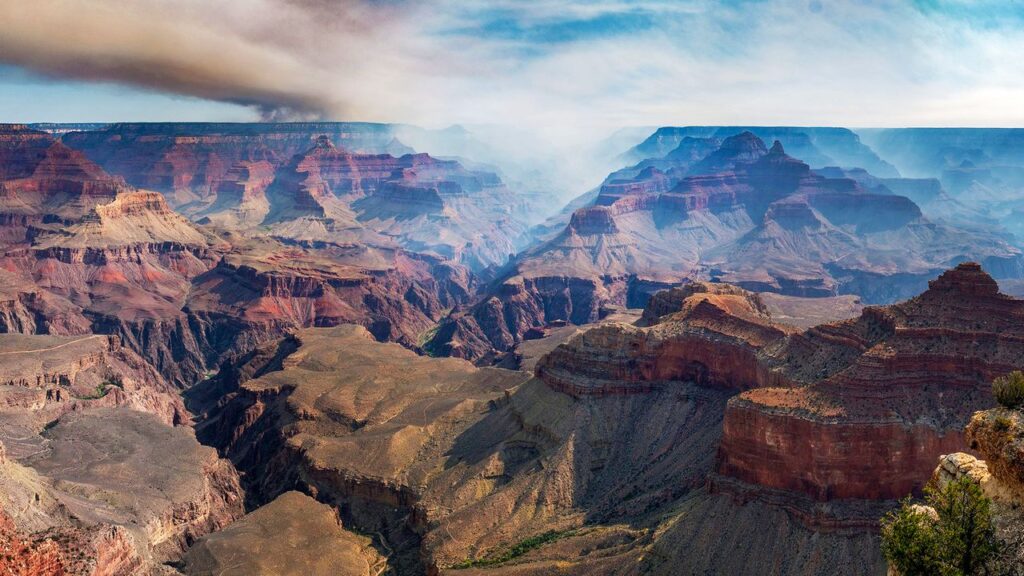Flames licking burnt-orange cliff edges; plumes of smoke blotting out the sun. These are the scenes currently meeting visitors at one of America’s most-treasured natural wonders, the Grand Canyon, where two wildfires have burned out of control since July 10.
As of July 16, the Dragon Bravo and White Sage fires continue to burn close to the Grand Canyon’s North Rim, forcing the evacuation of the area and causing the destruction of more than 80 buildings, including the historic Grand Canyon Lodge. If you have upcoming plans to visit the Grand Canyon National Park, here’s what to know.
Jump to
What caused the Grand Canyon fires?
Lightning ignited both the Dragon Bravo Fire (on July 4) and the White Sage Fire (on July 9) in northeastern Arizona’s Coconino County. Together, the two fires have burned more than 60,000 acres of land, according to the Bureau of Land Management’s wildfire tracking website.
After an early and fierce start to the season, 2025 is shaping up to be a severe wildfire year in the United States—as of July 15, 37,878 wildfires have burned approximately 2.57 million acres. Metereologists warned that hotter, drier conditions would escalate the risk of wildfires, leading some, including Arizona Governor Katie Hobbs, to question why the federal government opted to treat the Dragon Bravo Fire as a controlled burn during what Hobbs called “the driest, hottest part of the Arizona summer.”
What is the status of the Grand Canyon’s North Rim?
With both fires continuing to spread, the Grand Canyon’s North Rim will be closed for the rest of the 2025 season, which runs from May 15 to October 15 each year. Travelers will have to wait until spring 2026 to access visitor services and trails, including the inner canyon North and South Kaibab trails, as well as the Bright Angel Trail below Havasupai Gardens and the Rim-to-Rim trail that leads hikers 21 miles from the North to South Rim. Bright Angel Campground and Phantom Ranch, both located at the bottom of the Grand Canyon, around 9 miles from the South Rim and 14 miles from the North Rim, are also closed for the season.
As no injuries or deaths have been reported so far, the most significant loss to date has been that of the Grand Canyon Lodge, a National Historic Landmark located at the North Rim’s Bright Angel Point. Constructed with native Kaibab limestone and ponderosa pine logs in 1927—then rebuilt after a fire in 1936—the lodge was the last of the early 20th-century National Park lodges to remain intact. After it was reported to have been destroyed on July 13, Arizona Senator Ruben Gallego said: “Arizona lost more than a historic lodge, it lost a piece of our state history.” A statement from Aramark, the concessionaire responsible for the Grand Canyon Lodge, detailed that “guests with upcoming reservations will hear from us soon.”
Which parts of the Grand Canyon are unaffected?
While the North Rim attracts relatively fewer visitors (drawing just over 81,000 out of a total of almost five million Grand Canyon National Park visitors last year), the South Rim stays open year-round and is consistently busy. Fortunately, then, the South Rim has been largely unaffected. AAt the time of writing, Xanterra’s entire collection of Grand Canyon National Park Lodges, including the El Tovar Hotel and the Bright Angel, Kachina, Thunderbird and Maswik lodges, remain open—and have ample availability in July and August, and limited openings in September and October. The South Rim Visitor Center also remains open and ranger activities continue as planned.
That said, the National Park Service states that the current fire danger level for the South Rim remains very high and travelers should be mindful of restrictions, which include only lighting campfires in designated fire rings within maintained campgrounds.
https://www.cntraveler.com/story/grand-canyon-fire-travel-advice


